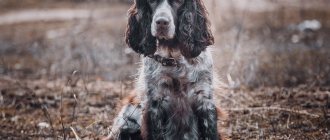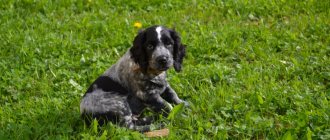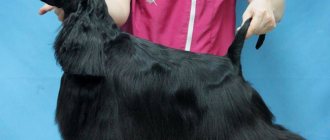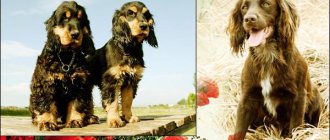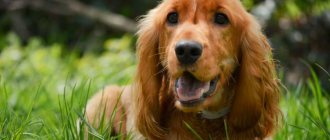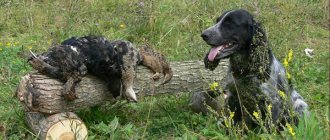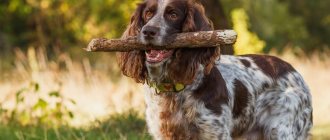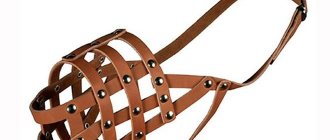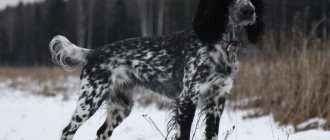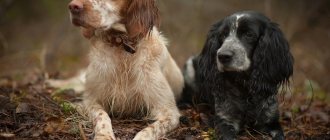Representatives of the breed are not suitable for a mixed diet. They can only be given a certain set of products or high-quality ready-made food.
In order not to harm the puppy, you should take into account other recommendations from veterinarians and experienced dog handlers regarding feeding spaniels.
Origin of the breed
In the 19th century, the favorite pastime of the Russian tsars was hunting; fabulous amounts of money were spent on the selection and maintenance of hunting dogs. Working hunting dogs were presented as expensive gifts from European monarchs to the rulers of Russian lands. With the advent of the English Cocker Spaniel in Russia, connoisseurs of elite hunting have become increasingly interested in game birds. But the short-legged, aristocratic English dog could not move with sufficient speed through the weeds and ravines of central Russia.
Interesting! The history of the breed is rooted in the creation of the English Cocker Spaniel breed, the Springer Spaniel and the desire of hunters to obtain a universal working dog for game birds.
By crossing various spaniels (mainly English and Springer), it was possible to obtain a relatively uniform dog. Purposeful breeding work began in 1927 in St. Petersburg. In 1945, Moscow became interested in the new species, and a club for breed lovers appeared. In 1949, intensive work began on developing a new domestic breed - the Russian hunting spaniel. The official birthday of the breed is 1951, the first standard was drawn up and a stud book was opened. Since 1972, the Russian Spaniel has completely stopped mixing genetic codes of other breeds.
Interesting! The Russian Hunting Spaniel is not recognized by the International Canine Federation.
Related breeds
The closest relatives of the Russian spaniel are the American and English cocker spaniels, but the difference between them is not only in color and coat type, but also in hunting instincts and constitution.
English cocker spaniel
The domestic spaniel differs from the English cocker in the shape of the skull and body. The Russian has longer legs and a more extended format. The English spaniel is more squat and stocky. Visually, the ROS looks small and light, but is not inferior in endurance and performance. The English “relatives” are not so willing to fetch game from the water, but they are not inferior in flair and thirst for hunting.
American Cocker Spaniel
The American Cocker Spaniel has a more aristocratic appearance compared to its prototypes, with clear lines of the head and back, and more abundant hair. He is inferior in height and weight, although he is just as active and hardy. Working American Cockers can be practically counted on one hand due to their aesthetic beauty. Increasingly, Americans meet at exhibitions rather than hunting.
Differences from popular species of the breed group
In Russia and Europe in general, three types of spaniels are most common - Russian, English and American. What are the fundamental differences between these dogs, because they are all spaniels. When considering purchasing a Russian Spaniel, you need to understand that this dog has retained its working qualities and must undergo testing. Over the years, “English” and even more so “American” dogs are increasingly becoming exterior dogs, that is, animals for show work.
The main differences between Russian and English spaniels are in size, build and development of working qualities. The English are family-oriented, while Russian spaniels are owner-oriented. In addition, the domestic breed has a well-developed guarding instinct. The description of the American Spaniel breed characterizes the dogs as working dogs, but in reality, this statement is far from the truth. Of course, with proper training, the “American” will search for, lift and serve the bird, and the Russian Spaniel is born a hunter. In addition, the hunting spaniel is easy to train and train; the breed is even recommended for novice hunters.
Dimensions of a lounger, booth, house or enclosure
Cocker spaniels are medium-sized pets. This determines the size of the bed, booth, house or enclosure.
Standards for the listed equipment for the breed:
• mats, rugs, beds, cribs – M or L; • booths, houses – rarely used, since the dog is a decorative breed, the size is determined taking into account the pet’s height; • cells – average dimensions are 75 by 53 by 60; • aviary – free space is achieved on an area of 1.2 by 1.2 m.
Cocker spaniels are a medium-sized breed, which is reflected in the selection of clothes, shoes, collars, and other items. It is advisable for the owner to know how the dog develops according to the norms in order to track whether the pet is growing correctly. Height and weight values indicate the health status of the animal.
How to measure a Cocker Spaniel correctly
To determine the weight, you should put your pet on a regular scale and record the result. To determine the height, you will need to learn how to correctly measure a cocker spaniel.
Recommendations and main measures:
- neck circumference - measurement is taken at the widest part, where the collar is usually located;
- the length of the dorsal part is from the beginning of the neck to the base of the tail;
- Chest circumference - measured at the widest point, usually behind the forelegs.
To ensure correct measurements, you will need to position your pet exactly. The back must be measured in a standing position along the spine. The dog should not stand or lie down.
Description and breed standard
A brief description of the breed is presented in the table:
| Short description | |
| Origin | Russia |
| Conditions of detention | Private house or apartment |
| Purpose | Hunting, gun, companion |
| Color | Solid, bicolor piebald, tricolor, with tan |
| Wool length | Middle length |
| Adult dog size | Height 36–44 cm, weight up to 20 kg |
| average life expectancy | 12–15 years |
| Walk | Mandatory, from 2 times a day |
| Need for physical activity | High demand - from 2 hours a day |
| Classification of the International Canine Federation (FIC) | Not recognized by the IFF |
| Puppy cost | From 5 thousand rubles to 20 thousand, depending on the pedigree and working qualities of the parents |
Description of parameters:
- General form. A compact, squat dog with a slightly stretched format. Strong, with good muscles.
- Head. Relative to the small size of the body, the transition from the forehead to the muzzle is pronounced, but not strongly, the occipital protuberance is weakly expressed. Scissor bite, full set of 42 teeth. The ears are hanging, located at eye level or slightly higher, the length of the ear reaches the nose. The eyes are symmetrically located, dark brown in color, not too prominent. The nose and rims of the eyelids are ideally black; in red colours, pigmentation to match the color of the coat is allowed. The lips are dry, fit tightly to the jaw, jowls cover the lower jaw.
- Neck. Set relatively low, with slight dewlap, strong, with well-developed muscles.
- Frame. Stretched format (stretch index - 110–120%). The chest is wide and deep, reaching to the elbow joint. The back is straight, the withers are well defined, the loin is short and muscular. The croup is quite sloping.
- Limbs. Straight, strong, parallel to each other, with good articulation angles. The hind legs are very muscular, the toes are arched. Pasterns without markings. The length of the front legs is equal to half the height at the withers.
- Tail. Located on the line of the back, held no higher than its level. In working dogs it stops after the fourth vertebra.
- Sexual dimorphism is pronounced. Its presence is encouraged, but females of the male type are not disqualified.
Congenital characteristics for disqualifying a dog:
- too large or small in height (dwarf) and weight of the stated standard;
- too aggressive;
- shorthaired or mongrel haired;
- solid white color;
- presence of malocclusion;
- mixed breeds with other spaniel groups;
- erect or short ears.
Coat and color
The guard coat of the Russian Spaniel is of medium length and coarse, lying close to the body, slightly wavy, but without curls. Longer on the stomach, ears, and paws than throughout the entire body. There is practically no undercoat. Due to the lack of undercoat and tight-fitting outer coat, the dog looks almost smooth-haired.
There are three varieties of colors:
- solid;
- two-color;
- tricolor.
Solid color can be: black, red, brown (chocolate). With all solid colors, white markings on the chest, paws, and tail are acceptable. Red can be any shade - from golden to reddish.
There are two-color ones: black and white, red and white, brown and white. Two-tone colors are also called piebald or harlequin.
Tri-color colors include solid black or brown with white markings and red tan, or piebald with black and tan markings on a white background.
Weight and height
The preferred height at the withers for males is 40 centimeters (+-2 cm), for females - 38 centimeters (+-2 cm). An adult male ideally should not weigh more than 20 kilograms, a female - more than 17.
It is important to know! Height and weight parameters are relative. The main thing is that the dog looks organic for its size and does not have excess weight. The exterior can only be fully assessed on a fully formed individual. Russian spaniels grow until they are 18 months old.
The need for parameter control
It is not at all necessary to control the height and weight of a four-legged pet if it is purchased from a reliable breeder. Having received a puppy of a certain breed, you can check what an adult dog will be like by looking at the parents, and become familiar with the stages of growth by reading the relevant literature.
Answers to questions about the puppy's development are of much greater interest to owners of animals received for free or even picked up on the street. Although it is quite difficult to answer exactly to what age mongrel dogs grow and, moreover, what they will look like in a few months or years. These answers are no less important for owners who see that their pet’s growth rate does not quite meet their expectations.
To monitor the development of a puppy, and then a young dog, it is recommended to periodically weigh it using ordinary scales and measure using a tape measure or centimeter. Until the puppy is 2 months old, measurements are performed once every 5 days, up to six months - every ten days, then - monthly. The height of the dog at the withers in a standing position, the circumference of the pastern (carpal joint) and chest are measured. Elbow height measurements may also be taken.
Breed characteristics
The Spaniel's personality is suitable for any person. Representatives of the breed get along well in families with children and single people, with experienced or novice hunters. Not suitable only for lazy people - the spaniel is too energetic.
He has a lively, playful disposition and behaves like a puppy until old age. Ready to follow the owner with its tail, wanting to attract attention. At the same time, it lends itself well to training and has remarkable endurance. Not prone to dominance, gets along well in a pack of several dogs.
It has excellent innate hunting qualities. Easily learns to retrieve ducks from the water and search for wounded birds. You can train to follow a blood trail, follow a hare, or even use a dog for fishing. The spaniel is more obedient than the husky, but is no less comfortable and hardy in hunting. It will not be difficult even for a novice hunter to develop a ROS into a universal hunting assistant.
Despite the versatility of the spaniel, we must not forget that, first of all, it is a gun dog. Its true purpose is to lift the bird on its wing. But the breed allows you to choose who to hunt.
Features of the development of different breeds
In the table below we will look at the main dog breeds and track how long it takes each of them to finally form.
Table. Growing up different breeds of dogs
| Breed | Period of completion of growth |
| German Shepherd | Active development is completed by the first year of life; a two-year-old dog is considered fully formed. |
| Rottweiler | Growth slows down by the first year of life, the formation of muscle structures ends by two and a half years |
| Yorkshire Terrier | Representatives of the breed are considered mature at seven to eight months. |
| Dachshund | Puppies complete their development by eight months. In the future, rates continue to increase in breadth |
| Pug | Pugs mature in different ways: some individuals become mature as early as six months, and some continue to develop up to nine to ten months. |
| Pekingese | The timing of the completion of growth depends on the sex: females, as a rule, mature faster than males, having grown up by eight months. Males take a whole year |
| Toy Terrier | One of the “earliest” breeds, completing development and growth by six months |
Character traits
This dog, an achievement of Russian breeders, is distinguished by its friendliness and cheerful, cheerful disposition. The pet becomes attached to its owner and is capable of becoming a reliable hunting assistant and faithful companion. He gets along well with other pets, especially if they grew up together from childhood. However, small pets like rats or hamsters may be considered prey and a hunt may be launched for them, which will sooner or later end in victory.
Distinctive characteristics of the breed, which some owners lovingly call “spaniel”:
- endurance;
- energy;
- excellent hunting sense;
- remarkable intelligence;
- persistence.
The spaniel is able to find and drive prey and bring it to its owner. She loves to swim, so she easily helps in catching waterfowl, primarily ducks. However, proper attention should be paid to raising a pet from the age of a puppy. The owner can have fun. Watching the baby's funny antics, but if you give him free rein, a stable habit will form. But it is impossible to retrain an adult dog.
The animal adores the children of its owner, plays with them with pleasure, has fun, but can show aggression towards strangers and especially unfamiliar children. Therefore, on the street, it is important to ensure that no one tries to pet the dog.
Nutrition
Dogs are “eternally hungry animals” - this popular expression very accurately describes the Russian Spaniel breed. But the diet should be rich in vitamins and minerals necessary for the development of a healthy dog.
Especially at a younger age, as puppies grow and need proper nutrition. If the new owner does not have enough time to prepare food, you can use ready-made food.
The owner’s primary task is to carefully monitor the volume of portions and their relationship with the dog’s physical activity. Otherwise, it will lead to obesity and its negative consequences.
Puppies of this breed should have 4-5 meals a day, with a time interval of at least 3 hours. You need to gradually accustom your dog to feeding twice a day (morning and evening).
Clean water must be constantly available to the animal. It is also important to keep an eye on the bowls and regularly pour boiling water over them.
Expert opinion
Anna Abramenko
An avid dog lover. Experience in veterinary medicine since 2009.
Ask a Question
The list of foods that dogs of this breed should not eat: river fish, seasonings and spices, fatty or smoked meat, fresh baked goods, sweets, legumes.
Authorized products:
- vegetables and fruits in season;
- ground bones;
- dried (stale) bread;
- lungs or stomach;
- intestine cuttings;
- legs, wings;
- sea fish without bones;
- rice, oatmeal or buckwheat cereals;
- cartilage;
- beef, rabbit, turkey or chicken meat;
- kidneys, heart, liver;
- kefir, low-fat cottage cheese, milk.
It is important to cook the intestines or stomach well so that the dog does not contract gastrointestinal infections. Before eating, it is enough to scald the meat, twist it into minced meat for very small puppies, and for 7-8 month olds it can be cut into small pieces.
Expert opinion
Anna Abramenko
An avid dog lover. Experience in veterinary medicine since 2009.
Ask a Question
It is advisable that the dog eats its entire portion, but if this does not happen, then the remaining food must be removed and the portion size reduced for subsequent feedings.
Spaniel hunters are given boiled waste from the hunt, so that later, when catching, the dogs do not tear the game.
Maintenance and care
Spaniels are not suitable for keeping in a kennel; the lack of undercoat does not allow them to feel good outside all winter. The ideal housing option is a private house, but with appropriate walking, you can keep a Russian hunter even in a small apartment.
Walks
Spaniels are very active dogs with a strong hunting instinct. They can cause trouble within the city, because they love to chase pigeons and other birds not suitable for hunting. This behavior must be stopped by methodically raising the dog, showing it the boundaries of what is permitted.
For long walks outside in winter or in very bad weather, it is recommended to use special protective clothing: raincoats and overalls for dogs. It is not advisable to toilet train at home - the animal is too active, and without a long walk it can exhibit destructive behavior.
Combing and cutting
The absence of a thick undercoat allows you to do without grueling daily combing. But dead guard hair needs to be removed about once a week. During the molting period - 2-3 times in 7 days. You need to use a fine-tooth comb or a furminator.
Working dogs receive exclusively hygienic haircuts. The hair is trimmed between the paw pads and around the anus. In order for the dog not to freeze while hunting, there is no need to cut it anymore, although after running through weeds and bushes, the appearance of the coat will have to be brought back to normal.
Cleaning ears and teeth
The ears and teeth of a completely healthy dog do not cause much trouble. You can take care of your teeth using special toothpastes and brushes designed for pets. Cleaning at home should be done no more than 2 times a month. Pets with dental problems tend to develop tartar every week. It is recommended to have the mouth examined by a veterinary dentist twice a year.
A healthy spaniel's ears do not require special attention. Cleaning can be done as the ear gets dirty (1-2 times a month), but you need to constantly monitor the condition of your ears. Working dogs are prone to infection with ixodid and ear mites, which lead to inflammatory processes in the body.
Antiparasitic treatment
Treatment for ectoparasites and helminths is very important for working spaniels. The hunting season coincides with the time of active hunting of the ixodid tick and it is not difficult to become infected with worms in the wild.
Preventive treatments against helminths are carried out at least once every 3 months. If the dog is infested, the procedure must be repeated after 10–14 days. It is more expedient to treat animals living in a flock at the same time.
Prevention of ectoparasites is carried out according to the instructions of the selected method. The choice of antiparasitic drug is up to the dog owner, depending on the pet’s individual tolerance and the owner’s financial capabilities. Each product has its own pros and cons, and it is up to the owner to decide which one to use.
What affects a dog's growth?
In addition to the breed, the rate of development of a dog is also influenced by external factors that the pet owner can take control of. Treating the dog’s body as a verified mechanism that improves independently and does not require participation is very dangerous. Sometimes dogs that did not receive proper care in their youth grow up underdeveloped (physiologically) and have many health problems in the future.
The growth of a pet is influenced not only by hereditary factors, but also by the actions of the owner.
Among the factors independent of the pet owner, one can identify heredity, which is sometimes unfavorable and negatively affects the dog’s health, preventing it from developing fully. Among the factors affecting the rate of growth and development of a dog, we note the following:
- food quality;
- the presence or absence of physical exercise and training;
- nuances of content.
We will talk about them further.
Nutrition
Feeding puppies is a very responsible task, since any mistake can lead to long-lasting consequences. To begin with, all puppies, regardless of their breed, consume their mother's milk for the first few weeks of their lives, which gives them enough strength to open their eyes and begin to move.
Puppies receive vitamins and microelements necessary for growth primarily from food.
If newborn puppies do not have access to their mother and are fed artificial formula, this may affect their growth rate. However, when using high-quality substitutes for bitch milk, such sad results can be avoided. The same cannot be said about goat or cow milk, which is not a worthy equivalent.
The frequency of feeding also plays an important role. The older the puppy gets, the less often he needs to be fed, and vice versa. Most one-month-old puppies eat every 3-4 hours, while adults eat only twice a day. Therefore, over the course of a year, the owner must gradually reduce the number of servings so as not to harm the puppy or leave him hungry.
Puppies must be fed on a strict schedule.
It is dangerous to immediately start feeding your puppy ready-made dry food, since the baby’s stomach simply will not have time to adapt to such solid food after milk. Dry food is introduced only from 2-3 months. Until this point, the puppy’s diet should include natural foods such as:
- cottage cheese;
- kefir;
- serum;
- cereals (served as porridge with milk);
- boiled vegetables (as a component of porridge);
- meat (beef, chicken or turkey).
In the first months of development, the main attention is given to dairy and fermented milk products. As the puppy grows up, meat gradually replaces milk, occupying at least 40% of the total amount of food.
Meat is included in the diet of most puppies already at the age of two to three months.
You can read more about how to feed a puppy in a separate article on our portal.
Training
You can start training puppies as early as two months of age, but you should remember that at this age the baby is close in its level of development to a five-year-old child. Therefore, you should under no circumstances require him to carry out “adult” complex commands. With such actions you will only injure your pet and cause him stress and overwork.
Training allows the puppy to develop not only physically, but also mentally.
Training will help the puppy not only better master his body by performing tasks, but also establish trusting contact with the owner if the person communicates with the puppy correctly. You can start training puppies with such simple commands as:
- "Place!";
- "Lie!";
- "Stand!";
- "To me!".
When training puppies, do not forget about rewards and treats to make training easier for your pet.
Some dog breeders at this age already teach their pets the command “Ugh!”, however, this command, unlike all those mentioned, is accompanied by negative reinforcement and therefore can cause negative emotions in the puppy. That’s why most trainers prefer to leave the command “Fu!” at a later time, when the puppy has grown up and can adequately cope with frustration.
However, one way or another, the owner will have to tell the puppy “No” one day, and it’s better to happen sooner than later. Teaching a dog boundaries is not a pleasant experience and requires a lot of patience, but it is easier to train a very young puppy than an adult dog with established behavior patterns. How to encourage a dog to obey its owner without becoming aggressive is discussed below.
Basic rules for raising puppies
In this section, we will not dwell on the generally accepted rules like “don’t leave puppies in a draft,” and will touch on the topic of health. In order for puppies to grow into viable and strong dogs, they will need immunity, which can be protected by:
- routine examinations at the veterinarian;
- deworming;
- vaccination.
Deworming
The younger the dog, the more seriously its body suffers from parasites. To prevent helminths from harming your pet, it should be periodically dewormed, starting from the age of three weeks. Subsequently, puppies undergo such prophylaxis at least once every three months. Adults only need deworming once a year.
Deworming must be done before the puppies are taken for a walk for the first time.
Important! Please note that when choosing an anthelmintic for young animals, you should choose drugs marked “For puppies”.
Vaccination
Puppies can have their first vaccination at six weeks of age, but it is rare that this procedure is done that early. For the most part, breeders take this step to minimize the likelihood of puppies becoming infected with parvovirus enteritis in the nursery.
Puppy vaccination schedule
The further list of vaccinations includes the following vaccinations:
- Comprehensive vaccination against parvovirus enteritis, plague, parainfluenza and infectious laryngotracheitis and hepatitis. Puppies are vaccinated at 7-8 weeks of age.
- Complex vaccination (from the same manufacturer) aimed at combating the same diseases, while introducing an anti-rabies component.
- Additional comprehensive vaccination given to 16-week-old puppies if their immunity has not yet developed.
Vaccinations are required for all breeds without exception.
When choosing vaccines, veterinarians mainly rely on the following brands:
- "Eurikan";
- "Nobivak";
- "Rabizin"
All of these vaccines are suitable for both puppies and adults.
By the way! It is believed that after the first sexual intercourse, the dog’s body stops developing. In this regard, many owners refuse early matings and wait 2-3 years to cross physiologically mature partners.
Video - How to vaccinate a puppy?
Breed diseases
The Russian Hunting Spaniel is a healthy breed, but there is a tendency for some diseases. Among them:
- otitis;
- obesity (prone to overeating);
- allergy;
- lacrimation.
By knowing breed predispositions, all diseases can be prevented. To do this, it is enough to monitor the quality, volume and diet, condition of the ears and eyes.
How long Russian spaniels live depends directly on their state of health. The average life expectancy is 12–15 years.
Vaccinations
Immunization of domestic animals against rabies is required by law. Vaccinations against all other viral infections are done at the discretion of the owner. But for working dogs, vaccination is a necessary procedure, since wild animals are carriers of viral diseases, including rabies.
Important! Veterinary institutions have the right to refuse admission if the dog is without a muzzle, no matter how kind it may be.
When to get the first and subsequent vaccinations, what types of viruses there are - find out from the table
| Age | Diseases | Notes |
| 6 – 10 weeks | Parvovirus enteritisLeptospirosisCarnivore plagueInfectious hepatitis | First vaccination |
| 10 – 14 weeks | Parvovirus enteritisLeptospirosisCarnivore plagueInfectious hepatitis | Revaccination |
| 10 – 14 weeks | Rabies | The first immunization, if the puppy is kept in a greenhouse, can be postponed until the change of teeth |
| 10–12 months | Parvovirus enteritisLeptospirosisCarnivore plagueInfectious hepatitis | Last puppy vaccination, repeated every year |
| 10 – 12 months | Rabies | Last puppy vaccination, repeated every year |
Adult dogs are vaccinated once a year, often using a complex vaccine against rabies and other common viruses. Before each immunization, it is necessary to carry out helminth prophylaxis.
Development of a young dog
The next stage, when the pet can be called a young dog, continues for most breeds until 16 months of age. In small breeds it ends earlier - even before a year. The period can be characterized by an active increase in body weight or size, and a complete cessation of development. Much depends on the following factors:
- from health in the early stages - active puppies grow faster and can mature earlier than their sisters and brothers from the same litter;
- the quality of the dog’s nutrition - a responsible attitude to the pet’s diet will allow it to develop longer and become larger - although not by much;
- from the sex of the animal. Females tend to be smaller in size and weight.
Size difference between male and female
The last stage of development is considered to be a period from one year to 2–3 years. At this time, small pets stop growing long ago, but large dogs can gain muscle mass. So, the answer to the question of how old do dogs grow to become fully grown depends on the breed. The smaller the dog, the earlier it matures. But even a representative of the largest breed - for example, a Newfoundland or St. Bernard - can well be considered an adult by the age of three.
Nutrition for puppies and adult dogs
Regardless of the owner’s decision on what to feed his dog, natural or dry food, it is necessary to follow the feeding regime. Adults, whatever the breed, need to be fed no more than 2 times a day.
It is difficult to choose a complete diet, rich in all the substances necessary for health, on your own. Therefore, many owners increasingly prefer industrial ready-made food.
Puppies' diet by month:
- Newborns - 1 month. The mother of the puppies monitors the feeding regime.
- 2 months. The breeder begins to feed the babies 2-4 times a day, depending on the number of puppies and the bitch’s ability to feed them.
- 3–4 months. Puppies are fed small portions every 3 hours, 6 times a day.
- 4–6 months. The interval between feedings and portion size are increased, food is given 4 times a day.
- 6–10 months. Teenagers are served breakfast, lunch and dinner.
- 10–12 months. You can gradually approach the regime of an adult dog - 2 times a day.
Clothes and shoe sizes for Cocker Spaniels
Cocker Spaniel clothing and shoe sizes vary depending on the pet store. However, general notations are accepted.
- Shoe size is determined in centimeters along the length from the heel to the claw line. In stores, shoes should be selected according to the length obtained.
- Clothes are measured using 3 measurements: chest and neck circumference, back length. The standard size for cocker spaniels is L. To make clothing loose, it is allowed to add 2-3 cm to the chest circumference.
Reviews
Nikolay, Ekaterinburg
“When I bought a cocker spaniel, I asked the breeders what kind of food the puppy’s parents eat. They said Royal Canin. I also started feeding my baby these super premium granules. The dog grew up strong and beautiful. Then I switched him to adult dog food.”
Nadezhda, Pervouralsk
“I wanted to feed my spaniel natural products. But this is very expensive and troublesome. At about seven months I switched the baby to ProPlan food and was not mistaken. And the puppy felt good, and I had more free time. Now I can take him on long walks.”
Puppy growth stages
The rate of development of a dog at the initial stage of its life is subject to certain patterns that are not related to the breed. Moreover, the beginning of growth is usually considered to be the period when the puppy is still an embryo, being in the mother’s womb. At this time, the formation of the animal’s body occurs, which is why it should only be taken from a responsible breeder who monitors the health of pregnant females.
The second stage is the life span from the birth of the puppy to 1.5 months. This period is called suckling and is the same for all breeds. This period is the same and lasts up to six months. During this time, the dog develops molars, its height at the withers approximately doubles, and its weight triples. Up to 6 months, puppies’ ears also grow, and by the end of the period they acquire the same shape as those of an adult dog.
How to choose a puppy
Before you go for a puppy, you need to study its pedigree and talk with the breeder about the working instincts of the parents. Breeders and nursery owners are willing to make contact with the future owners of their charges. If you travel far, you can ask to send a photo or video of both parents and the babies themselves to assess their condition. An obvious breed defect is noticeable even in photographs.
You should not buy puppies from dogs whose breed is in doubt, or if they are kept in poor conditions (on a chain, in a kennel on the street). It is impossible to predict how developed the hunting instinct is in such individuals. Parents who are kept in terrible conditions often have a huge number of genetic and acquired diseases. Caring for a puppy from such breeders can be expensive, troublesome, and ultimately futile.
Prohibited Products
A balanced menu means feeding your dog healthy foods while excluding prohibited foods.
The list includes:
- raw cabbage;
- millet cereal;
- semi-finished products;
- avocado;
- spices, pickles, smoked, fatty foods;
- bones of rabbits and chickens;
- pork;
- river fish and any types of raw fish;
- mushrooms.
Onions and garlic are conditionally prohibited foods - they can be given occasionally. In addition, cold and hot food, as well as food prepared from expired ingredients, are harmful.
If you follow these rules, then raising a healthy, cheerful and active dog is very simple. Another important condition is sufficient attention to the pet.
The end of growth depending on the breed
How long do dogs grow? When assessing the development and growth rate of a puppy, it is necessary to take into account the breed and constitution.
How old do toy terriers grow? Small breed dogs develop much faster, while large dogs stop growing later.
Let's give some typical examples.
To what age do small breed dogs grow? They develop rapidly and complete their growth in about six to nine months. To what age do Yorkies, Chihuahuas, and Toy Terriers grow? Yorkshire terriers and chihuahuas grow until about eight months, and then only “get stronger.” In the toy terrier (that's right - Russian toy) growth ends earlier - already at 6 months.
How old do large breed dogs grow? Their development takes longer, up to about eight to ten months. For example, in a representative of the wonderful Husky breed, the active growth phase ends at nine months. To what age do medium breed dogs grow? Large pets take the longest to grow. For example, a German Shepherd puppy finishes its growth only at 12 months and after that it gains muscle mass for about a year.
However, if the diet is not followed, the physical development of the pet can slow down significantly. Proper diet in the first eight months is extremely important, as this time is crucial in order to raise a healthy and strong dog.
Nicknames for Russian Spaniel
The choice of a nickname for a working dog should be primarily aimed not at aesthetics, but at how the dog will remember it and respond to it. The nickname should be clear, short, and sonorous. You should avoid words that are difficult to pronounce or too long - it may be difficult to call when hunting.
For boys
Suitable names for spaniel boys:
- Robie;
- Roy;
- Rudy;
- Barney;
- Raf;
- Oscar;
- Roni;
- Kai;
- Kevin;
- Radar;
- Noah;
- Ren;
- Eric;
- Hoshi.
For girls
Suitable nicknames for girls spaniels:
- Molly;
- Dolly;
- Lucky;
- Laura;
- Dory;
- Nika;
- Mary;
- Boni;
- Lika;
- Sparta;
- Bullet;
- Puma;
- Us;
- Whiskey.
Learning ability
In terms of learning ability, the “star” character can again play a cruel joke. The Cocker must be constantly praised, but scolding is prohibited. The dog will understand the reproachful tone, but will simply demonstratively not react to the scream.
On the scale of intelligence and intelligence, a cocker deserves five points, but with reservations. We need to find an approach to this proud handsome man. He must be the best and the first in everything - the owner’s praise is the best incentive for training.
To punish a cocker, you don’t need to scold or shout at him, just ignore the dog. It’s not there for you, that’s all. Spaniels are very worried about their owner's inattention and will try to immediately correct their mistake, which caused your displeasure.
Education and training
Russian spaniels are diligent students, especially when it comes to learning how to hunt game. The innate desire to search for and raise a bird is so strong that special training is often not needed. With systematic training to find and retrieve birds, the spaniel will become a universal hunter.
How to train, how many commands to study - this must be decided by the owner from the moment the puppy arrives at home. You can train a spaniel in basic obedience at home, without the help of specialists.
It is important to know! The main thing is to be consistent, methodical, calm. Before starting training, you need to decide: what a dog needs to know in order to become comfortable and useful for the owner.
Estrus, mating and pregnancy
Owners of females not intended for breeding are recommended to undergo complete castration before the first heat. This will save you from many problems during collective hunting and hormonal imbalances in the body. Owners of bitches with breeding value need to understand that during estrus and pregnancy the dog will fall out of heat.
Estrus occurs during puberty - from 6 to 11 months, depending on the characteristics of the body. Mating is allowed to be planned no earlier than the third heat or upon reaching the age of 18 months. The male is looked for in advance, and the female is taken to the male’s territory for mating on the 10th–15th day of estrus. A veterinarian can predict a good day for mating after examining a female dog in heat. Females remain pregnant for 56–64 days.
Peculiarities of puppies growing up
Each puppy, regardless of breed, grows up according to several similar principles. There are two main periods, which are accompanied by their own developmental characteristics - before six months and after.
Puppies up to six months
Newborn puppies grow the most actively, since by six months they need to increase in weight three times (compared to their parameters at birth), and also double in height. Up to six months, puppies grow exclusively in height (if they are not overfed).
It is important for puppies up to six months to have foods in their diet that help strengthen bones.
The main danger that awaits the puppy at this stage is incorrectly formed tubular bones. This type of bone continues to grow for several months after the puppy is born, so it is important for the owner to ensure that they develop properly. You can help your animal’s body with a balanced diet that contains the following microelements:
- calcium;
- phosphorus;
- magnesium.
One of the main sources of calcium for a puppy is fermented milk products.
In some cases, veterinarians may prescribe vitamin supplements containing the above elements. However, it is not recommended to give your puppy any supplements without appropriate indications.
Puppies older than six months
Six months after birth, the puppies' chest bone begins to enlarge due to the active growth of flat bones, as a result of which the pet becomes visually wider. Such changes occur at a rapid pace until the age of one, and then slow down significantly.
After six months, external changes in the appearance of puppies become less noticeable
However, despite all the invisibility of subsequent development, the animal will need at least three years for all its bones to be fully formed. As already mentioned, this is important to take into account for those owners who want their pets to take part in mating.
Water
In addition to a properly selected and balanced diet, the dog needs a sufficient amount of fluid, otherwise the risk of dehydration increases.
The main rules for watering a puppy:
- keeping the bowl freely available;
- cleanliness of the liquid;
- regular water renewal;
- compliance with the temperature regime – 20-25 degrees;
- systematic cleaning of dishes.
Dog trainers recommend choosing bottled or filtered water for your puppy. It is better to refuse boiled, raw is strictly prohibited.
Hunting with a Russian Spaniel
With the Russian Hunting Spaniel, hunting turns into an exciting sporting competition. This is the best gun dog - it does not leave the hunter, flawlessly carries out commands, and does not drive the game too far.
With a Russian Spaniel you can go hunting for any type of game birds or small furs. This breed is excellent for searching for wounded animals or holes, following a blood trail. ROS can not only lift a bird under a shot, but also bring it back to the hunter. It is noteworthy: spaniels get excited very quickly, and in this state they are ready to work in any weather conditions.
Interesting! At the end of the twentieth century, Russian spaniels were used to hunt even small ungulates.
Hunter reviews
Real reviews from owners:
- A very beautiful, kind and active dog. Even if you don’t go hunting with her, she forces you to walk a lot, and this is good for your health. Her husband always takes her with him, even on fishing trips, and never returns empty-handed.
- Excellent working qualities. Although the puppy was not taken from hunters, on his first trip to pick mushrooms, the little puppy “obtained” a mouse den - he smelled it and dug it up! After some training, we went with him to duck - he picks him up and pulls him out even from impassable reeds. I advise all bird hunters to get a Russian spaniel.
The best ingredients for a productive hunt are a Russian spaniel, a gun and a hunter.
Video review
The presented gallery of photos and videos will help you understand more clearly which dogs are the breed standard and which are a deviation from the norm. Here you can also get acquainted with the appearance of not only adult spaniels, but also their puppies.
The Russian hunting spaniel, like any other breed, has a number of both positive qualities and disadvantages. And it is important to take all of them into account when deciding whether to adopt a dog of this breed or not.
It is worth noting the fact that spaniels have more good qualities than bad ones. And this description of the breed, its abilities and character will help you make the final decision.
Types of feedings
First you need to understand the types of feeding for small cockers. The breed responds positively to all three standard feeding methods:
- ready-made dry mixtures;
- natural products;
- mixed type: dry food is supplemented with wet food, meat, cereals.
When preparing a diet, it is important to take into account the dog’s temperament.
There are adherents of each type of food; it all depends on the choice of the owner. However, the fundamental factor when choosing the type of feeding should be the character of the animal and the purposes for which the owner got the pet. For example:
- Sports dogs that are trained to participate in hunting, fishing, hiking, and sports should choose dry food. It must be of high quality. Such foods contain a lot of protein for muscle development, support of ligaments and the skeletal system, as well as carbohydrates, which provide energy. In addition, it is convenient to take dry food with you to feed your pet during training or fishing.
- “Sofa” pets can be given natural products - meat, soups, cereals. However, a veterinarian’s consultation is necessary here: perhaps the individual needs of the pet’s body require a more competently selected menu.
- It is recommended to give puppies natural foods. During growth, their digestive system must become stronger and learn to process hard fibers, and their teeth are renewed from careful chewing before switching to dry food.
Many spaniel owners opt for dry food
As a rule, most dog breeders choose convenient feeding with dry food. They are trying to get away from the mixed type for several reasons: it is uneconomical and problems arise in creating a complete diet. In addition, the dog’s body may not accept mixed food - to digest dry and natural food, different enzymes and absorption periods are needed.
Period from birth to 6 months
From birth to six months, a healthy, active puppy should increase in weight by three times, and grow at the withers by two times. At this time, dogs only grow in height.
This stage is characterized by the cessation of growth of tubular bones. Therefore, it is very important that at this time everything is formed according to the norm. Improper, unbalanced nutrition, serious illnesses can negatively affect the development of the bone frame, resulting in deformations and obvious disorders that cannot be corrected.
In this case, the adult will have incorrect body proportions, which will put an end to exhibitions and participation in competitions.
